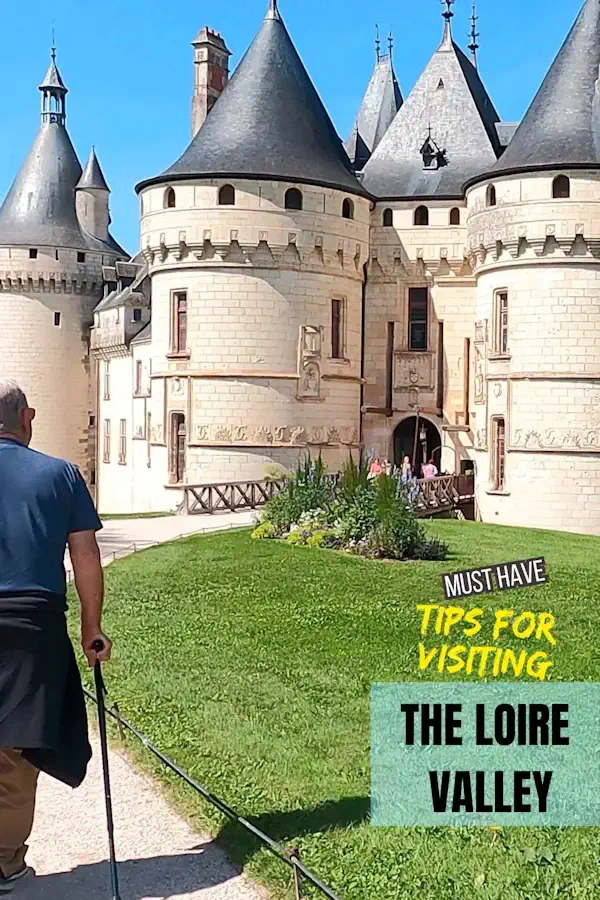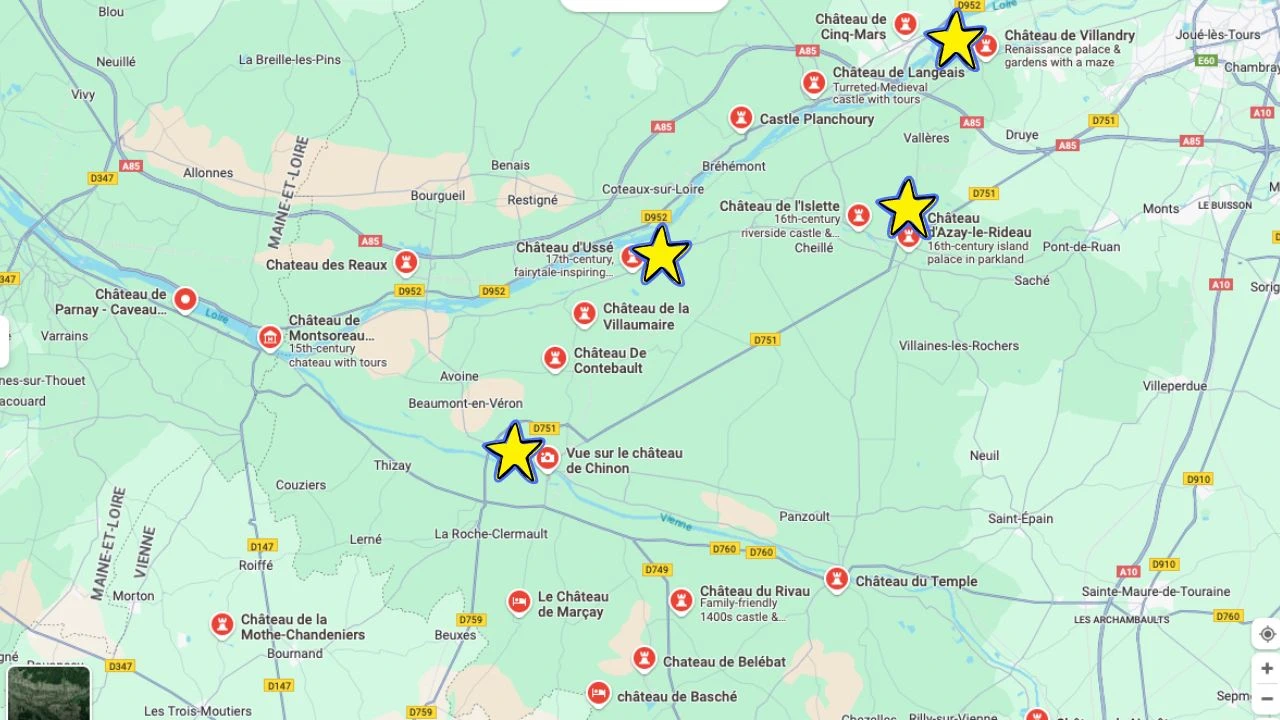by Celeste Lipford and Terry Lipford - last updated on 9/30/2025

Amboise is adjacent to the widest stretch of the Loire River and it is a pleasant place to visit with a nice old town directly below the hilltop chateau. To add even more interest, Leonardo da Vinci retired and owned a home here (Château du Clos Lucé). Leonardo da Vinci is buried in the Chapel of Saint-Hubert, located on the grounds of the Château d'Amboise in Amboise, France. This small Gothic chapel is a highlight of the château and is notable for its intricate architecture and historical significance. Da Vinci was invited to Amboise by King Francis I and spent his final years at the nearby Clos Lucé, passing away in 1519. His burial at the chapel adds an additional layer of cultural and historical importance to the site
Amboise was stop # 3 on our Loire Valley adventure, primarily because it was to be our next "Base Camp", and secondly because there were a large number of chateux within a hundred kilometers of the village. 53 kilometers northwest of Amboise lies the Château de Chambord, a flamboyant masterpiece built by King Francis I. 12 kilometers southwest is the majestic Château de Chenonceau, known as the "Ladies' Château," and the impressive Château de Villandry, famed for its stunning Renaissance gardens.
Amboise under King Francis I also reflected his ambition to blend French and Italian Renaissance styles, which shaped the architecture and art of the region. The Château Royal d’Amboise hosted court events and became a hub for political and artistic life, showcasing the king's vision for a modern, culturally enriched France. The enduring legacy of Francis I in Amboise is evident in the château’s rich history, its connection to prominent figures like Leonardo, and its role as a centerpiece of the Loire Valley’s Renaissance heritage
Parking in Amboise
Parking in French villages can be a challenge, and Amboise is no exception. There are Payant Parking Lots alongside the river, and there is "curbside parking" throughout the city, but Amboise is a popular destination and these parking lots & curbs fillup early. You have to be patient and quick in order to get a parking spot! Be sure to read the Payant Machine instructions carefully and leave your receipt on your dashboard where the meter reader can see it.
More Info for Amboise, France
Amboise has had a wide range of history including; the Roman Legions (Julius Caesar and the Gaul Campaign), in fact, the majority of Julius Caesar's 10 year long Gaul Campaign took place east of Amboise between Bourges and Dijon. Vercingetorix surrendered to Caesar after the battle of Alesia (50 miles west of current day Dijon). The Merovingian Frankish ruler Clovis met with Alaric king of the Visigoths and signed a famous treaty in Amboise. Charlemagne's Carolingian Empire, the Capetian dynasty (987–1792), the House of Bourbon and the French Revolution.
The city's origins date back to Roman times, but it gained prominence in the Middle Ages as a strategic location due to its position on the river and proximity to key trade routes. The town is best known for the Château d'Amboise, a royal residence that became a favorite of French kings in the 15th and 16th centuries. King Charles VIII was born there and died after a tragic accident in the château.
During the Renaissance, Amboise became a hub of culture and politics. Leonardo da Vinci spent his final years in Amboise under the patronage of King Francis I, and is buried at the Château’s Chapel of Saint-Hubert. The Château also played a key role in France's religious wars, particularly during the Amboise Conspiracy, an attempt to overthrow Catholic leadership.
NOTE: This is the same King Francis I who played such a crucial role in Catherine de' Medici's life in France. The TV Series "The Serpent Queen" about the 16th century queen of France Catherine de' Medici, follows history very closely and is interesting, informative & entertaining if you are history buffs like we are.
For a complete list of who rules what & when, go to this Wikipedia Page for more details. The Chateau de Amboise has gone from Royal Residence to becoming a prison. Since 1840, the chateau has been a museum owned by the State.
As of April 2025, there are approximately 275 hotels and places to stay in Amboise, France, according to Booking.com. Amboise offers a number of accommodations that blend historical ambiance with modern comfort. Below are five highly rated places to stay according to Google Review Ratings:
We rented a really nice "gate-house" cottage that was located on a vineyard. It provided us with our own private entrance & parking, completely modern interior and parking was right next to the cottage. Less than a 10 minute drive from Amboise, and the ratings and reviews on VRBO are excellent. If you are looking for a comfortable place for a couple to stay in, we would recommend this VRBO cottage to you.
If you would prefer to do your own Amboise accommodations research, here is a link to a Google Search Results list for "accommodations in Amboise, France" sorted by "most popular rating". You can resort this list in any manner you prefer once you are on that page.

Amboise boasts a vibrant culinary scene with numerous dining establishments. According to Tripadvisor, there are approximately 102 restaurants in Amboise. This diverse array includes traditional French bistros, modern eateries, and international cuisines, catering to a wide range of tastes and preferences. The following list is comprised of the most popular restaurants in Amboise, based upon Google Review Ratings as of April 2025.
If you would prefer to perform your own restaurant research, click here to view a Google Search Results list for "amboise france restaurants".
Amboise offers a variety of activities that showcase its rich history, Renaissance heritage, and natural beauty. Here are the top things to do:
Planning how to reach your destination can depend on a lot of factors—your starting point, time of day, weekday vs. weekend schedules, the number of travelers in your group, and your preferred mode of travel. Whether you’re traveling solo or with family, and whether you prefer high-speed trains, guided tours, flights, or flexible options, we want to make your journey easier to plan.
Below, we've listed trusted travel providers that offer reliable ways to get to this destination—or to explore it once you're there. From booking transport to reserving day tours, these companies offer a wide range of helpful services.
Expedia is a one-stop travel platform offering flights, trains, rental cars, and accommodations. In addition to helping you reach your destination, they also own VRBO, making it easy to book everything from hotels to vacation rentals in one place. If you're planning a full itinerary, Expedia is a strong starting point.
Viator specializes in curated tours and activities, including transfers and day trips that can help you explore the area once you’ve arrived. Whether it’s a wine tour in Provence or a guided walking tour of Old Nice, Viator partners with local experts to provide high-quality experiences.
Get Your Guide offers a wide selection of tickets, tours, and transportation options across Europe. From airport transfers to scenic train rides and full-day excursions, it’s a great resource for both getting there and finding fun things to do after you arrive.
Getting to Amboise
We drove to Amboise, however the distance between Paris and Amboise puts it solidly in the "day trip possible" category. Train service from Paris to Tours and then on to Amboise is available. You would need to find a bus tour to the Chateaux listed on this page, or rent a vehicle.
Tours Val de Loire Airport (TUF) is the closest airport to Amboise, however you would still need to acquire transportation to the Chateaux on this page.
Amboise is a historic town on the banks of the Loire River in central France, about 25 km east of Tours. It’s part of the Loire Valley UNESCO World Heritage region.
Amboise is famous for its royal château, its connection to Leonardo da Vinci, charming cobblestone streets, and panoramic views over the Loire River.
Amboise is easily reached by train from Paris (about 1.5 hours via Tours or Saint-Pierre-des-Corps) or by car along the A10 motorway. The town is also a popular stop on Loire Valley cycling routes.
Spring and autumn offer mild weather and fewer crowds, making them ideal for sightseeing. Summer is lively with festivals but can be busier; winter is quieter and more relaxed.
A one-day visit is enough to explore the château and Clos Lucé, but staying 2–3 days allows time to enjoy the markets, river views, and nearby Loire Valley châteaux.
Amboise is considered a worthwhile destination from Paris, particularly for those interested in the Loire Valley castles and Leonardo da Vinci. While some may find its château less impressive compared to others, many appreciate its historical significance, scenic views, and overall appeal.
Amboise is moderately wheelchair-friendly, particularly for the Château d'Amboise and the gardens of Clos Lucé, but some areas, like the upper floors of the château and parts of the towns' streets, may have limited access. The Château d'Amboise offers accessible parking, a free lift to key areas, and a virtual tour (Histopad) for inaccessible sections. Clos Lucé's park is fully accessible, though the residence itself is mostly limited to the ground floor.
 Click the above image to view a larger Google Map
Click the above image to view a larger Google Map
There are quite a few chateaux within a one hour driving distance circle from Amboise, which makes it a perfect basecamp for you to stay at while visiting this part of the Loire Valley. Below you will find the set of chateaux that we decided to visit. Use the provided lik to go to that page to read about that chateaux.
Château de Chenonceau is such an unusual château that it attracted our attention during the research we undertook before our trip. The castle is built over the Cher River and is connected by two bridges. The main bridge is a double-decker bridge, with the ground floor used for horse-drawn carriages and the upper floor used for pedestrians. The second bridge is a single-decker bridge that was added in the 19th century. You can see the arches underneath the château; these are wide enough to allow boats to pass through.
Château de Chenonceau, also known as the "Ladies’ Château," captivates visitors with its enchanting design spanning the River Cher and its history shaped by influential women, including Diane de Poitiers and Catherine de Medici. This Renaissance masterpiece offers lavishly decorated rooms, period furnishings, and stunning galleries with riverside views.
Click here to view our Château de Chenonceau page and see the unique architecture, fascinating history, and picturesque setting of this beautiful château.
Château de Chambord stands out as the largest and most awe inspiring chateau!. Its sheer size overwhelmed us as we approached, its silhouette rising surrealistically above the surrounding trees. That initial glimpse of the Château remains indelibly etched in our memories. It evoked images of bygone days when guests would have been summoned for grand hunts, with men on horseback armed with bows, spears, and swords. We could almost hear the echoes of their triumphs, accompanied by lavish feasts and celebrations. The incredible size of the estate and the buildings is unforgettable.
Click here to view our Château de Chambord page and see the history and natural beauty, with trails for walking, cycling, and wildlife spotting of this beautiful château and estate.
Located in the village of Cheverny, and only 42 kilometers from our rental in Amboise; The current building was constructed between the late 16th and early 17th centuries, however, there had been a house there since at least 1315. The current building represents classical French architecture and offers visitors a glimpse into the opulent lifestyle of the French aristocracy.
Click here to view our Chateau de Cheverny page and see the château’s richly furnished rooms providing you with a glimpse into aristocratic life, with period art, furniture, and décor.
Located in the village of Azay-le-Rideau and 16 kilometers from our rental in Amboise; Built between 1518 and 1527 this château is considered one of the foremost examples of early French renaissance architecture. Set on an island in the middle of the Indre river, this picturesque château has become one of the most popular of the châteaux of the Loire valley.
NOTE: If you have been watching the TV mini-series 'Franklin' then you might be wondering if the person in the series named Jacques Donatien Le Ray Chaumont owned this chateau? The answer is yes, he purchased this chateau in 1750.
Click here to view our Chaumont-Sur-Loire page and see the beautifully landscaped gardens, contemporary art exhibitions, and scenic river views.
Originally constructed in the 15th century, Château d'Amboise played a significant role in the French Renaissance and was a favored residence of several French kings, including Charles VIII and Louis XII. Its unique blend of Gothic and Renaissance architectural elements reflects the transition from the medieval to the modern era.
Click here to view our Chateau Royal d'Amboise page and see the final resting place of Leonardo da Vinci,.
The following list contains links to all of our other French Destinations & Information Pages, click any link to go to that page.
Note: All images featured on this page are the exclusive property of Just Traveling Thru, LLC, unless otherwise stated. When images from external sources are used, full credit is given to the original creator, along with a link to the specified license or usage terms. We are committed to respecting copyright and intellectual property rights, ensuring that all third-party images are properly attributed. If you have any questions regarding image ownership or usage rights, please feel free to contact us.
Affiliate Links: We may earn a commission if you make a purchase through one of our affiliate links. This helps support our travel content — thank you!
Content: To review any of our content, make suggestions and/or comments, please click the "About" menu link at the top of this page. You will find our "Contact Us" link on that drop-down menu.